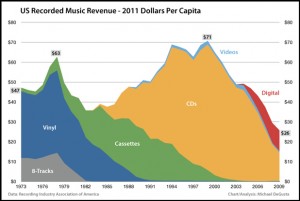Music in the Digital Age
The decline of the music industry has been well documented. But music is as popular as ever. So what gives?
I know I’m buying more music than ever because of price, convenience and availability. The cost of an album has gone way down and I can buy music 24/7 without leaving my house. In the old days I’d schedule a trip to Tower Records when I had a little extra money to browse through the racks of CD’s. It was always a thrill to take home the 3 or 4 I could afford (except for the agony of unwrapping since CD covers were designed by a malevolent fiend intent on making opening the package as frustrating as possible) and pop them into the player. Now I use Amazon, eMusic and iTunes for music purchases. Often I’ll hear something I like on WFUV, which I listen to on my Mac during the day, or on XM or the local jazz station and I’ll search for that song or album and buy it right away. Instant gratification!
So why is the music industry suffering? And is it really suffering? It turns out the answer is yes, especially if you compare the last decade to the previous one. First, it’s widely known that the emergence of the CD as the dominant form of music delivery was an unprecedented boon for the music business in the 80’s and 90’s because people bought music they already owned. Second, piracy is a real issue. Music fans today have grown up with the attitude that music should be free because technology has enabled them to share it.
How bad is it? Check out this chart from an excellent article on the Business Insider site:
What does this chart tell us? Recorded music sales in the US have declined 64% from their peak in 1999. Digital music sales are growing but have not made up for the overall decline. Another chart in the same article shows that album sales have declined precipitously in the last 10 years. People are buying individual songs rather than albums. (Wasn’t it that way it was in the 60’s before the rise of the LP?) Enabling technology and public pressure have forced the business to unbundle music that used to sold in packages of 10 or more songs. When you think about it, the album was an artificial construct anyway. Great albums were best listened to in their entirety but, let’s face it, there weren’t many of those. Most people want to buy individual songs. So it looks like people are still buying lots of music but the units they’re buying are smaller, resulting in lower overall sales.
What about piracy? How much of it is hype? According to the RIAA, piracy is a big problem and one of the causes behind the decline in revenues. In 2001 the average American spent almost 3 times as much on recorded music as they do today. In 1985, they spent almost twice as much as they do today. (Turns out I’m an exception.) A recent study estimated that only 37% of music acquired by consumers in 2009 was paid for. Estimates on lost revenue range from $4 to $20B. Since these numbers come from industry groups, they can be taken with a grain of salt but there’s plenty of evidence that the industry is in distress. Music labels have laid off thousands of employees and even well-known bands are struggling to make a living.
It’s obvious we’re witnessing an industry undergoing severe disruption. So what’s next?
It looks like the industry’s expectations were set artificially high in the 90’s. The advent of the CD and the economic boom of that decade gave the business a boost that wasn’t sustainable. The industry needs to hit the reset button.
The good news is total music sales are up for the first time since 2004. And the industry now tracks sales of single songs, albums and “track-equivalent albums,” which aggregate singles into hypothetical albums. (A laughable concept. Shows how slowly the music industry is changing.) Sales of digital singles are up 11% according to the NY Times and sales of albums are either up 1% or 3.6%, depending on how you define them (see above).
Live music is a bright spot. Revenues are growing as more bands realize this is a key source of income for them.
Digital distribution is another reason for optimism. Bands are being forced to use alternative forms of distribution. iTunes, CDBaby and Soundcloud, among others, are creating platforms that sell music. Bands can reach fans directly by creating Facebook pages and websites. Soon, they’ll have Gigmor, our musician matching site as a great alternative to MySpace. (So we hope.) The result is a lot more choice for consumers and the opportunity for bands to bypass the traditional gatekeepers and reach a worldwide audience directly. The new world has millions of bands who can now afford to record and publish their songs without relying on the traditional gatekeeper system controlled by the music labels. They make tiny amounts of money from selling their music but have the bragging rights that they control their own destiny. The music industry can leverage this ecosystem to pluck out proven stars to minimize their risk (see #YouTube #JustinBieber). The decline in industry revenues is certain to level off—sooner rather than later, I think. And the direct-to-artist revenues will continue to increase.
Speaking of digital distribution, I’ve been using Spotify recently and think it’s a gamechanger. I’ll look at music subscription services and their impact in my next post.

Comments are closed.